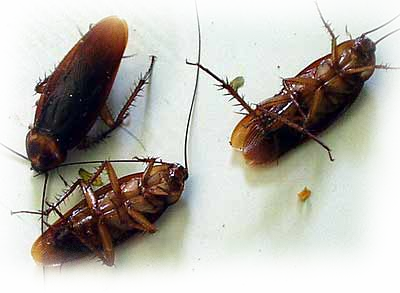Roaches
Roaches
Anyone who has tried to catch cockroaches knows that this is no easy task. What is their secret? For one thing, tiny hairs on each side of their abdomen register the slightest air movement caused by enemies and reveal the direction from which it comes. Also, their nervous system appears to be extremely efficient, as the roaches need only one hundredth of a second to react and run away. Now, by means of a high-speed camera, Jeffrey Camhi and his colleagues at the Hebrew University of Jerusalem have learned more, reports the newspaper Berliner Morgenpost. They found that roaches can run at a speed of three feet [1 m] a second and at this speed can even change direction up to 25 times a second. “We know of no other orientation behavior in any animal capable of such a high frequency of body turning,” said Camhi, quoted in New Scientist. “If the cockroach were not such a bad house guest, it would no doubt receive the admiration it richly deserves.”
Roach Biology And Habits
Cockroaches live, feed and reproduce in most all types of structures including homes, apartments, restaurants, office buildings, nursing homes, hospitals, factories and most anywhere where people work, live and play. Cockroaches eat human food and non-food items and contaminate them with saliva, fecal droppings or glandular secretions. Roaches are suspected of transmitting a variety of diseases, but are most often implicated in the transmission of salmonella, the causal agent of food poisoning.
Cockroaches are typically nocturnal insects appearing only during the day when disturbed or when there is an excessively large infestation. Cracks and crevices are favored hiding and breeding areas.
In the Pacific Northeast there are four cockroach species which may be encountered in structures: Brownbanded, American, Oriental and German.
| Brownbanded Cockroaches are more apt to be found in private residences than incommercial buildings, and they are more common in eastern Washington than in Western Washington. Brownbanded prefer to hide in warm areas near the ceiling, behind wall decorations and loose wallpaper, in closets, beneath or inside upholstered furniture, and in electrical appliances. These cockroaches may infest any room within a dwelling and therefore thorough inspection and treatment is necessary. |  |
| American Cockroaches are the largest cockroach species, which infest dwellings and can reach lengths of 1 1/2 inches. The American is quite rare in this state and most infestations are brought in with produce or in the furniture of persons moving from warmer climates. When established, these roaches prefer warm, moist environments. In the south, they are abundant in sewer systems, damp basements and poorly ventilated warehouses. |  |
| Oriental Cockroaches are relatively uncommon in Washington and are most often found in the eastern part of the state. It is more commonly found in restaurants and other commercial buildings than in residences. It tends to prefer cool, moist areas wherever it occurs. The oriental feeds on a wide range of decaying organic matter and have the reputation of being the filthiest of the household infesting cockroach species. | |
| The German Cockroach is the most commonly encountered cockroach in apartments, restaurants, hospitals, or other buildings in which food is stored, prepared, or served throughout the Pacific Northwest. Under ideal conditions, adults may live up to 12 months. The German produces more eggs and has more generations per year (three or four) than other cockroaches, and thus a troublesome infestation can rapidly develop after the introduction of a few individuals. These cockroaches are often accidentally introduced into buildings with groceries, beverage cartons, and used furniture and appliances. Adults may also migrate from nearby infested dwellings. Most migration occurs along plumbing or utility tunnels or between apartments in structures. German cockroaches normally inhabit the kitchen and bathroom but will also occur in other rooms, especially if infestations are heavy. During the day these roaches may be found hiding clustered closely together under, around or even in the insulation found in the walls of appliances such as stoves, refrigerators, and dishwashers; around sinks; beneath or around water heaters; in cracks around, under, or inside cabinets, closets and pantries; and behind baseboard moldings. Other places may include telephones, toasters, coffee makers, and other small appliances, behind pictures, wall hangings or electric clocks. |  |
The Enduring Cockroach
Although millions have heard the lilting Mexican folk song “La Cucaracha” (The Cockroach), not many housewives actually burst out singing it when they see the little insects darting for cover in the kitchen. To most people, roaches are annoying pests. They are not attractive in appearance, at least to us. They carry diseases. Their pungent odor is repulsive.
Yet, despite such human abhorrence, roaches continue to abound. Their great reproductive capacity, coupled with the scarcity of natural enemies and the roaches’ ability to adapt and protect themselves, quickly generates an amazing population. The common German roach, for example, can easily have over 35,000 descendants in a year. That is the average, not the maximum, which may exceed 100,000 a year. How so? The German roach’s ootheca, or egg case, may contain up to 48 eggs. The female roach produces seven ootheca during her average 140-day lifetime. If everything goes well for the roaches, with each female in each generation producing the same amount, tens of thousands of roaches are generated in a remarkably short time.
Most of the over 3,500 species of cockroaches live outdoors, unnoticed by humans. But a few, such as the German variety, favor man’s buildings for their home sites. Actually, the national names (American, Australian, German, Oriental, and so on) are really meaningless. Europeans, it is said, would name the roach after neighboring countries. The Romans called it lucifuga, from its habit of fleeing from light. The English word “cockroach” is from the Spanish cucaracha.
Some entomologists report a happy family life among roaches. Adults have been observed carrying little ones piggyback. Mothers have been noted helping the emerging young to escape from the egg capsule. After hatching they are often kept together and brooded by the mother, and a colony of nymphs, or young ones, will usually be found with a few older ones.
Not Choosy Eaters
Roaches feed on almost anything. They will eat whatever humans eat, as well as many other things, such as leather, hair, wallpaper, and animal carcasses. They also eat books—especially if they are soiled by perspiration—and will eat the bindings to get at the paste. In some parts of the world, parchment cannot be used for legal documents because it is so often damaged or destroyed by roaches. They relish dirty areas and filth but may infest even the most sanitary places.
Actually, roaches do not need much food. A dozen of them can live for a week on the glue of just one postage stamp. Water is more important to them, which is why they are most often found in kitchens or bathrooms.
Cockroaches have been accused of being carriers of bacteria and viruses that cause infectious hepatitis, food poisoning, urinary-tract infections, skin infections, allergies, and dysentery—to name a few. As they wander about, they contaminate food and utensils and leave an unpleasant odor, which is the combined result of their excrement, the fluid that they exude from scent glands, and a dark-colored fluid that they regurgitate to soften their food before eating it. Dishes that are soiled should be thoroughly washed and then scalded; otherwise, when hot food is put in the dish, the offensive odor will come back.
Redeeming Values?
Is there anything good about a roach? Actually, it is a quite complex little creature. The roach’s sensors detect changes in air pressure and temperature, as well as locate water and warn of approaching predators. Roach antennas have 40,000 nerve endings that do the touching, tasting, and smelling for the roach. The largest sense organs of the cockroach are the compound eyes, which are made up of many small lenses, and yet the roach does not see objects clearly. It is, however, very sensitive to movement and is quick to notice even minute changes in light intensity. The cerci—the forked pair of appendages at the end of the abdomen—detect vibrations as well as sound or air movement and thus trigger the insect’s escape reaction of scurrying into the nearest crack or crevice. Alarmed, a roach can react in as little as 0.054 second and dart away!
A roach breathes through spiracles, portholelike openings on each side of its body. A huge tube that runs the entire length of the body pumps blood. Decapitated, a roach can still survive for over a day—long enough for a female to deposit her eggs safely. The American roach can live up to six weeks without any food or water.
An amazing creature, yes, but of what benefit is it to mankind? Well, for one, it is a known enemy of bedbugs. And because of its size and ease of rearing, the American roach is often used in laboratories for scientific research. Japanese researchers, for example, had at one time successfully used a roach extract in treating liver disease in laboratory mice and were optimistic that it would also work on humans. Some fishermen use the Oriental roach as bait for catching bream, a sunfish. But this little fellow is essentially a scavenger, doing the work for which he was created: returning trash, garbage, and dead carcasses to the earth.
Ridding the Home of Them
“How did these insects get into my house?” asks the housewife. Well, they—or their eggs—may have come in grocery bags, sacks of potatoes or onions, in beverage cartons. They may have flown in. Since a roach can flatten itself, they might have walked in right under your front door. And if you or your guests have visited an infected place, they may have hitchhiked on shoes or clothing. In apartment houses, they can enter by passing through cracks in walls or floors or by traveling the “roach highways”—the common water and steam pipes.
How do you get them to move out and stay out? Fastidious housekeeping is essential. Likely hiding places, such as cracks and crevices in floors, baseboards, and vents, should be cleaned frequently. Keep clean all spaces around stoves, refrigerators, and cabinets. Clean up food spills and crumbs completely and immediately. Do not leave unwashed dishes overnight in a sink or a cabinet. Keep food stored in tightly closed containers. Since dry dog or cat food may provide a picnic for roaches, it is best to store it in a container with a lid and to avoid putting out more food than the pet will eat. Inspect incoming grocery bags and soft-drink containers for hidden insects and their eggs. Remove trash and garbage from the house daily. Repair all dripping faucets. Remember, though, while keeping the kitchen clean will make Senõr Cucaracha feel unwelcome in the kitchen, if you eat your meals in your living room or den, you may find you are inviting him in there.
If a room is badly infected, a pesticide may be necessary. Too much spray, however, may work against you. The roaches will either avoid it or become immune to the poison. So read the label carefully and follow the instructions exactly. Pay attention to precautions, and be especially mindful of children, the elderly, or anyone who has a respiratory problem.
Serious infestations often require professional help. Because it takes 30 days for roach eggs to hatch, monthly services may be needed for a while. If you do call a professional, the following will help. Thoroughly clean the kitchen before he comes, and be sure that food and dishes are removed from cabinets. Dishes and utensils may temporarily be placed on a table and protected with a plastic sheet. Food items may be stored in the oven or in the refrigerator. If the pest-control technician offers some suggestions or recommends changes, be sure to consider them.
The war against roaches has been going on for some time. And the roaches have been fighting back. They have become resistant to most pesticides that have been used over the years. Now scientists are turning to biological weapons. A newly developed compound, a synthetic hormone called hydroprene, keeps roaches from reproducing by keeping them in the juvenile stage. However, even though sterile, that generation keeps on living. So results are not immediately seen unless hydroprene is combined with another pesticide.
Whether these pests will be eliminated from households or not remains to be seen, of course. So far la cucaracha has endured and has done remarkably well.
Tips: on how to rid Your Home of Roaches
- Keep entire kitchen clean. Give attention to all spaces around and under stoves, cabinets, and refrigerators.
- Frequently clean all possible hiding places—such as cracks and crevices in floors, baseboards, and vents. Where possible, caulk cracks and crevices in kitchens and bathrooms.
- Remove trash and garbage daily.
- Store food in tightly closed containers.
- Clean up spills and crumbs immediately and completely.
- Examine all incoming bags and containers for insects and their eggs.
- Practice moisture control. Repair all water leaks, and do not soak dishes overnight.
Click On The Pest Category To Learn More.
| Bedbug Guide | House Centipedes |
| Carpenter Ants | Mosquitoes |
| Clothes Moths | Roaches |
| Fly Facts | Ants vs Termites |
| Little Black Ant | Termites |
| Odorous House Ant | House Flies |
| Fruit Flies | Rodents |







